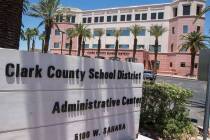How will the Clark County Commission change with three new Democrats?

It will be the same party but new faces on the Clark County Commission come January.
Democrats seeking three commission seats emerged victorious in this year’s midterm, marking the seventh election in a row the party has exerted total control over what might be Nevada’s most powerful elected board.
While the story of Democrats’ dominance of the commission is familiar, this election marks a new chapter for the county due to term limits.
State Sen. Tick Segerblom and former Sen. Justin Jones will be new faces on the seven-member commission. Former Henderson Mayor Jim Gibson, appointed to the board after Mary Beth Scow resigned in June 2017, will start his first four-year term. Another new Democrat will be appointed to take the place of Commission Chairman Steve Sisolak, who is leaving after 10 years to become Nevada’s governor.
The departing commissioners — Sisolak and term-limited officials Chris Giunchigliani and Susan Brager — spent much of their tenure guiding the county through the Great Recession. Their replacements will take office amid rebounded tourism numbers and a heated construction market.
“I think it’s an exciting time to join (the commission) and make sure, if there is another economic downturn, to diversify our economy,” Jones said.
Segerblom said he views “Las Vegas as being in a golden age right now,” with the county having more money to invest in public services and local infrastructure.
“We can catch up to where we used to be and spend on some things we couldn’t afford to do,” he said.
No seismic shift expected
But while each commissioner will bring an agenda to the commission, UNLV history professor Michael Green says county residents likely won’t see any seismic shifts to local government, at least not immediately.
Though all seven commissioners are Democrats, they are beholden to voters from different areas of the Las Vegas Valley with varying interests, said Green, who studies the evolution of Nevada politics.
“You come in with big plans, and that’s great. But it doesn’t mean you achieve it in a day or even a single four-year term,” he said. “On the commission right now, you’ll have Tick Segerblom, who certainly is a liberal and has no problem saying so, and Jim Gibson, whose family historically were conservative Democrats. They won’t agree on everything.”
Tuesday’s election results furthered solidified the idea that Clark County residents have embraced the Democratic Party, Green said.
Voter turnout in each commission race this year was virtually double that of the 2014 midterms, and all three Democrats won by larger margins than their party’s incumbents did in 2014. Even Jones, who faced a Republican opponent with a $1 million war chest, won his race by 8 percentage points.
Republicans’ future
Green said local Republicans could get trounced again in 2020 unless they distance themselves from President Donald Trump and his controversial political positions.
“Republicans have pretty well staked out their position nationally, and I don’t see local leadership breaking away that easily,” he said. “If it’s working in Missouri or North Dakota or Indiana, it doesn’t necessarily work here, but it’s hard to stand on the beach and yell at the tide to stop.”
Some Republicans officials are more optimistic about their party’s chances.
County party whip Jordan Ross said the GOP saw some success in Southern Nevada this year by expanding its voter base, opening more field offices and using millions of dollars from the Republican National Committee to improve its ground game.
‘This is a long game,” Ross said. “Growth in a dense urban area takes longer. But we feel like we’re headed in the right direction, and we’ll see that pay off in the next two election cycles.”
Contact Michael Scott Davidson at sdavidson@reviewjournal.com or 702-477-3861. Follow @davidsonlvrj on Twitter.



















